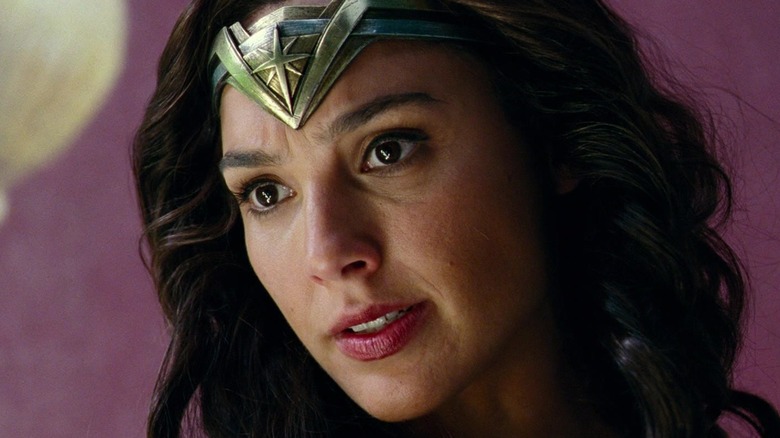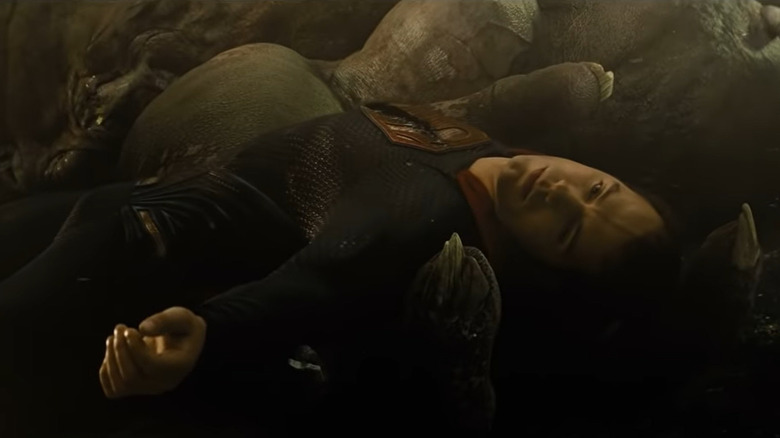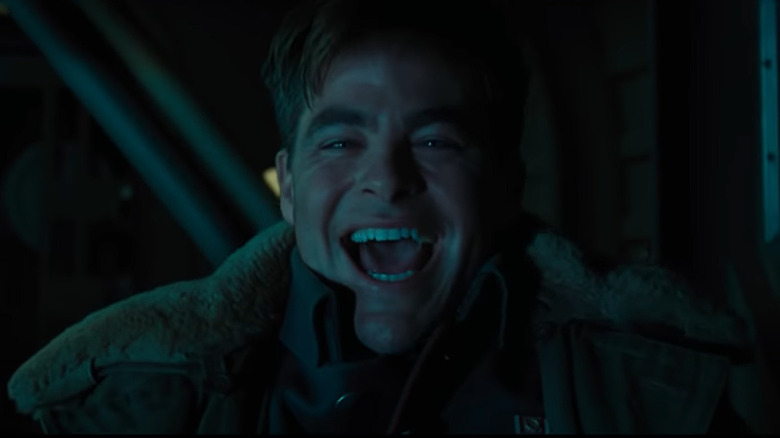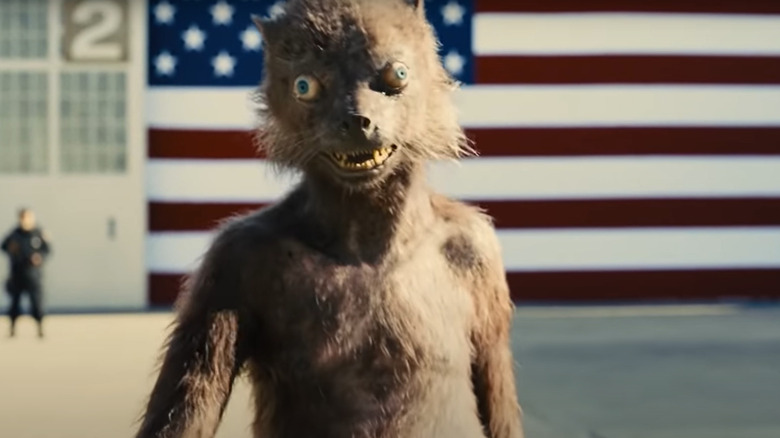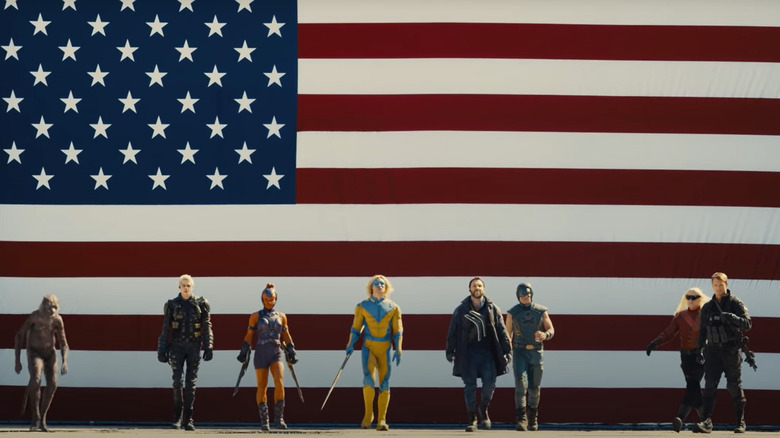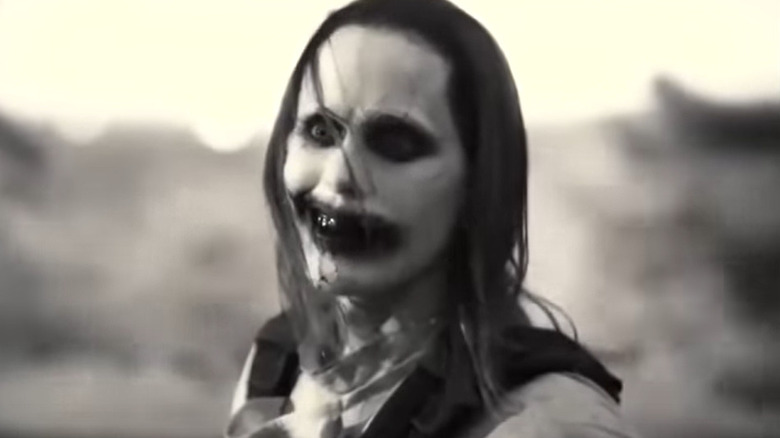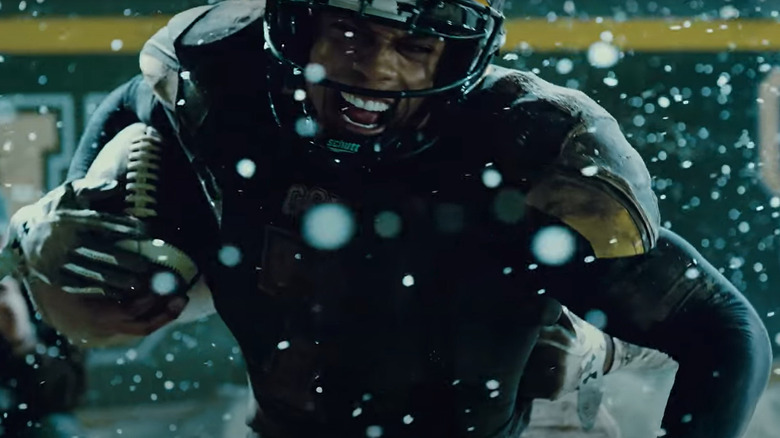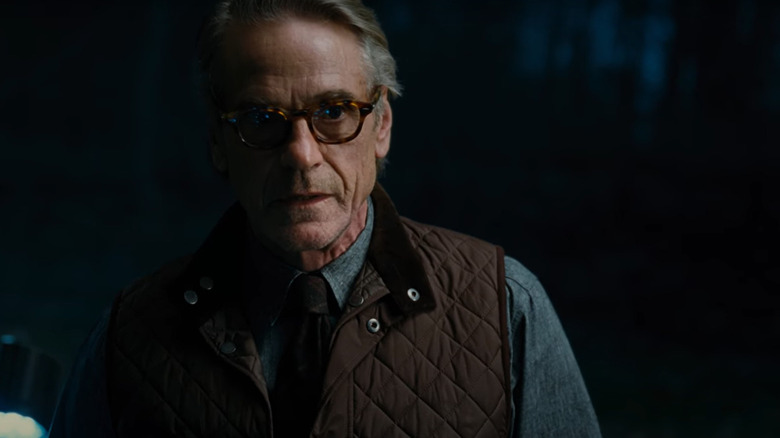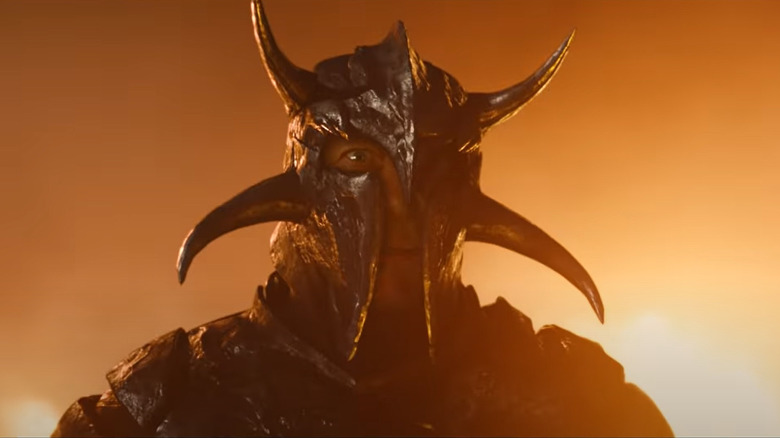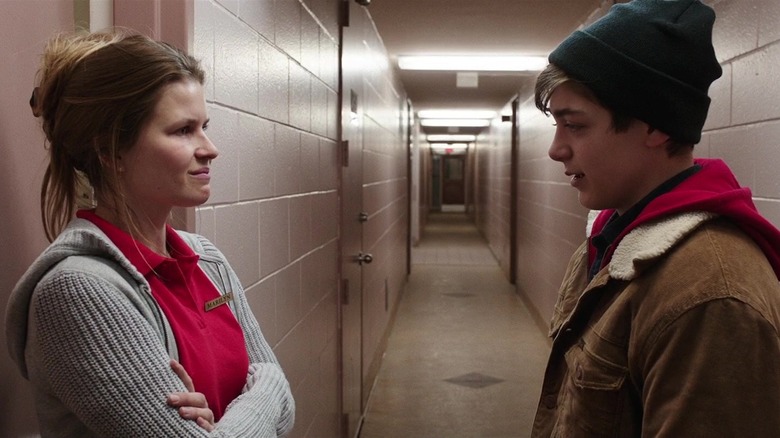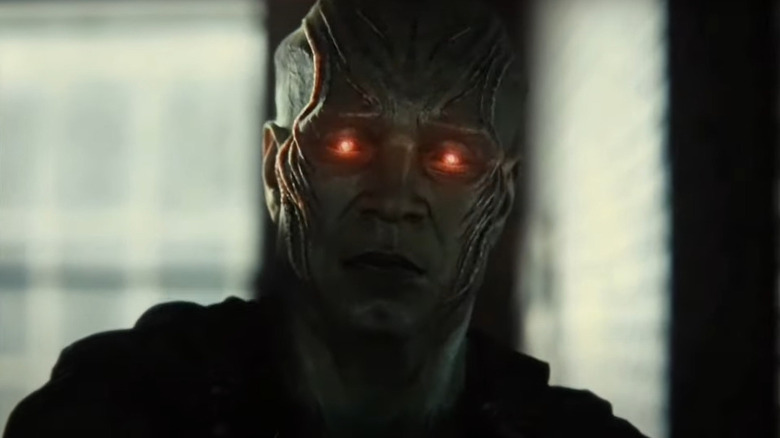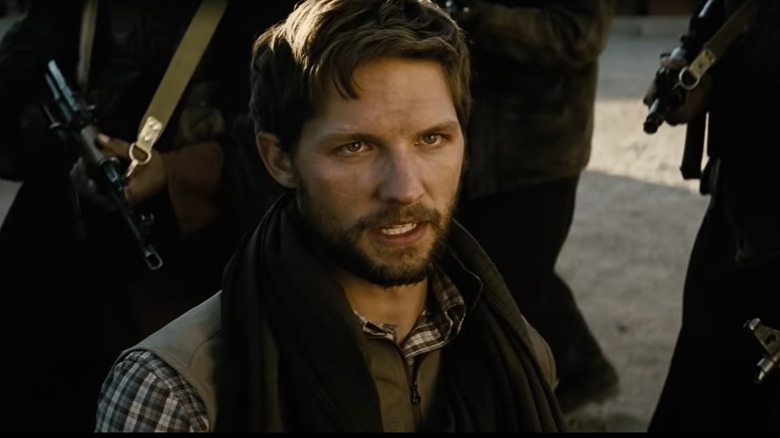The Biggest Red Herrings In The DCEU
Though it had a bit of a rough start, the DC Extended Universe (aka the DCEU) has carved out its own entirely unique identity. While plenty of big-budget action films deliver what are essentially 90-minute versions of their trailers, the DCEU keeps its audience guessing. No matter how you feel about it, who saw the grim conclusion of 2013's "Man of Steel" coming? This shocking choice set a precedent for a whole new generation of live-action DC heroes.
In the DCEU, characters with decades of history in other media can become entirely new people. In 2020's "Birds of Prey," a character named Cassandra Cain never even remotely approaches Batgirl-related activities, despite the fact that she takes up that mantle in the comics. Max Lord's legacy of deceit and mind control is transformed into a complex relationship to power and his son in 2020's "Wonder Woman 1984." Starro the conqueror — arguably DC's answer to Galactus the world-eater — gets killed by rats in 2021's "The Suicide Squad." Rats, for cryin' out loud!
You truly never know what you're going to get from the DCEU. What other swerves has this fantastic franchise tossed our way over the years? Let's find out by taking a gander at the biggest red herrings in DCEU history.
The death of Superman
1993's "The Death Of Superman" instantly became one of the most talked-about stories in the history of DC Comics. Of course, we can credit a lot of that hullaballoo to shock value — in the early '90s, demonstrations of mortality were largely unheard of among widely-recognized comic book characters. Superman's bloody final battle against Doomsday ends the legend created by Jerry Siegel and Joe Shuster with a shockingly brutal scene: Clark Kent bleeding to death in Lois Lane's arms on the streets of his beloved Metropolis. Since then, comic fans have gone without new Superman stories. The Man of Steel slowly rots in his coffin, dead as a doorknob.
Okay, you got us — we're completely joking. Superman definitely came back to life. Pretty much nobody thought Superman would stay dead for long, even at the time, but the apparent demise and resurrection of one of the genre's biggest characters is still a pretty big red herring. The DCEU's slaying of Superman plays out similarly — basically the whole audience instantly recognizes it as temporary, especially given the floating pebbles glimpsed above his coffin at the end of 2016's "Batman v Superman: Dawn of Justice." Yet it remains an act of major misdirection. Killing off Supes is, simply put, a huge deal, no matter what happens afterward. Thus, Superman's return in 2017's "Justice League" fills fans with rapturous joy, no matter how skeptically they treated his alleged demise.
Steve Trevor's heroic sacrifice
While we mean no disrespect to Steve Trevor, whether we're talking about the version played by Chris Pine in the Patty Jenkins-directed "Wonder Woman" movies or any other incarnation, he's hardly an icon of Wonder Woman's magnitude. He also doesn't come close to touching Superman, the DCEU's other resurrected gent. It's fine and good to get smug about easily predicting Superman's return from the ostensible great beyond — of course he's coming back, no matter how well-engraved his tombstone might be. On the other hand, the reversal of Steve's death following his noble self sacrifice at the conclusion of 2017's "Wonder Woman" stands as a genuinely surprising twist. Unlike Superman, Steve — a regular, non-superpowered guy and technically a secondary character — seems entirely killable. When he dies for the sake of a better world, a viewer naturally assumes it'll stick.
The onscreen chemistry between Pine and Gal Gadot contributes more than its fair share towards making "Wonder Woman" one of the DCEU's best-reviewed movies to this day, however. So it's not tricky to figure out why Jenkins and other invested parties wanted Pine back for the sequel, "Wonder Woman 1984." Thus, Steve Trevor lives again in the age of parachute pants. That means that when we see Steve heroically blow himself to bits in "Wonder Woman," we're being fed a plate of grilled red herring.
Weasel's improbable return
Batman and Superman are multi-million dollar intellectual properties whose good names cannot be deliberately sullied in a major movie. Meanwhile, most folks haven't heard of the second-stringers who star in "The Suicide Squad." All kinds of humiliating, terrible stuff can happen to them, and the Warner Bros. corporation and the viewing public will be totally fine with it. In fact, they downright expect it.
Everyone definitely thinks it's okay to abuse Weasel (Sean Gunn), a once-forgotten baddie reimagined entirely in "The Suicide Squad." Despite having an appearance comparable to a man-sized sewer rat or an awful dog monster — and his alleged history of murdering children — Weasel surely won at least a few hearts when "The Suicide Squad" arrived on various screens. It takes all kinds, after all — even people with a soft spot for bug-eyed fur demons.
For members of the newly-formed Weasel fan club, the sight of their problematic fave drowning on his first mission is a bummer, if hardly a surprise. In a later mid-credits scene, however, Weasel spits up water, rises, and runs across the beach. It's a fantastically unexpected moment, but Weasel is clearly insane and honestly pretty useless. This prompts a question: Of all the Suicide Squad members, why does Weasel deserve to survive their ordeal? Because he's the greatest, as Weasel fans will tell you, and star of one of the DCEU's most delightful red herrings.
The first 15 minutes of The Suicide Squad
As you might expect, trailers for "The Suicide Squad" don't give away too much regarding which characters will end up taking center stage. There are a whole bunch of them on parade, and though one can safely guess Harley Quinn (Margot Robbie) will make a major splash, given her popularity, few certainties announce themselves beyond her. So when the film begins by focusing on Savant (Michael Rooker) and a set of associates including Captain Boomerang (Jai Courtney), T.D.K. (Nathan Fillion), Javelin (Flula Borg), Mongal (Mayling Ng), Blackguard (Pete Davidson), and Weasel, every previous experience fans have had watching an action movie has them assuming these are characters who will stick around.
And then, all of a sudden, they pretty much all die! Most of them are riddled with bullets, though Mongal burns to death — it's pretty gruesome. Weasel survives, of course, but that's not made clear until the credits roll. The rest of the squad winds up thoroughly massacred. The first 15 minutes or so are deliberately designed to make us think one thing, when the actuality of the situation turns out to be completely different. It is, in short, a classic red herring — perhaps even a blood red herring, if you catch our ghoulish meaning.
The Joker's take on living in a society
While he might pop up again somewhere down the line, as far as the official word goes, Jared Leto's tenure as the Joker is complete. This means we can view the actor's contribution to the onscreen legacy of the Clown Prince of Crime in its totality, stacked up next to performances by Cesar Romero, Jack Nicholson, Heath Ledger, and Joaquin Phoenix. Nicholson might've been more of an innovator, and critics vastly preferred Ledger and Phoenix ... but only Leto's Joker attacks Batman with a meme.
"We live in a society" became the internet-preferred shorthand for brooding pseudo-profundity in the late '10s. It enjoyed a roaring and ironic second wind in response to 2019's "Joker." DC ignored almost 59,000 fans who demanded Phoenix say the line in the celebrated film. Luckily, "Justice League" director Zack Snyder gave the people what they wanted ... in a manner of speaking.
For his 2021 recut, "Zack Snyder's Justice League," Snyder shot footage of the Joker talking to Batman (Ben Affleck) about, yes, society. Oddly, this moment takes place in the chaotic, post-civilization hellscape that is the Knightmare timeline, which does not, in fact, resemble a society. This bit of dialogue appears in a trailer, but not the final version of the Snyder Cut. Nevertheless, thanks to the magic of the internet, we can still watch as the Joker tells Batman, "We live in a society."
Victor Stone, football hero
These days, it's incredibly common for footage to show up in trailers promoting a movie, but not the movie itself. This is particularly true for superhero-oriented endeavors. Marvel's trailers deliberately lie, in an effort to throw fans off the scent. While the DCEU does not appear to have purposefully planted any red herrings in their promotional materials, we do know that Zack Snyder shot a whole bunch of "Justice League" scenes that didn't make it into the 2017 theatrical cut, but did feature in its trailers.
Included among the discarded footage is a sequence depicting Victor Stone (Ray Fisher) kicking butt in a football game. Victor's experiences as a promising athlete are a major part of his characterization: They represent the life he loses when he's injured in the car accident that kills his mom and prompts his father to transform him into Cyborg. Their absence constitutes a particularly bitter red herring for Cyborg fans everywhere.
Luckily, his past on the gridiron does make it into "Zack Snyder's Justice League." Yet neither version of the film addresses whether or not Cyborg remains good at football after becoming a living technological miracle. He probably does, right? If he can go toe-to-toe with Steppenwolf, presumably his capacity to catch pigskins and dash 'em across the touchdown line has, if anything, improved. While he'll never be able to go pro, given his massive advantage, we propose the formation of a superpowered football league.
Alfred greets a mysterious visitor
Like Victor Stone's athletic feats and Barry Allen (Ezra Miller) zapping through a pet shop's window, a scene in which Alfred Pennyworth (Jeremy Irons) greets an unseen visitor made it into the "Justice League" trailers, but not the actual movie. "He said you'd come," Alfred intones to this mysterious guest.
We can safely presume that most viewers guess that Alfred is addressing Superman. "Zack Snyder's Justice League" restores this sequence, and confirms as much: Superman regains his senses after a rough trip back from the grave and checks in with Batman's butler/mechanic/medic/father figure to get caught up on the unfolding annihilation of all life on Earth.
Superman is the only truly likely person Alfred could be talking to: The Green Lantern Corps needs more time to rehabilitate its image after 2011's disastrous "Green Lantern," and the Martian Manhunter isn't famous enough to warrant that sort of gravitas. But at the same time, not everything is about Superman. Alfred could have been talking to Hawkgirl, who happens to be a key character in the celebrated '00s "Justice League" cartoons. He could also have been addressing Dick Grayson, whose thin history with the League is dwarfed by his popularity. Basically, Warner Bros. owes a big apology to anybody who bought a ticket to "Justice League" in the hopes of seeing Alfred greet a surprising new face.
Sir Patrick Morgan's pacifist leanings
When you're on the hunt for the literal god of war, you're probably not expecting him to appear in the guise of an aging British diplomat whose stated intentions all pertain to reducing World War I's body count. But as "Wonder Woman" charges toward its grand conclusion, we discover that the ostensibly harmless Sir Patrick Morgan (David Thewlis) is actually Ares, the movie's big bad.
After Sir Patrick reveals his true identity to Wonder Woman, he tries to convince her to join him in his quest to wipe out humanity. By Sir Patrick's account, he strives to undo the damage mankind has done to the environment, and put the Greek gods back on top as the planet's most elite creatures. In response, Diana makes a speech about the power of love and compassion, then demonstrates the limits of her compassion by blasting Ares to smithereens with an onslaught of lightning bolts. Maybe Wonder Woman isn't always ideologically consistent, but we'll be darned if she doesn't get the job done. She's not even thrown off by the massive red herring that is alleged pacifist Morgan's true self, the decidedly non-pacifistic Ares!
Billy Batson's biological mom
2019's "Shazam!" lacks a bona fide A-lister like Batman or Superman. Nor does it have the sardonic humor of "Birds of Prey" or "The Suicide Squad." But with its protagonist's journey to self-actualization and its indomitable optimism, "Shazam!" is, in many ways, the most traditional superhero movie of the DCEU era.
Because of this, when, after years of failed attempts, Billy Batson (Asher Angel) successfully tracks down the mother he thinks lost him by mistake when he was a toddler, we expect a happy reunion. Instead, we find out that Marilyn Batson (Caroline Palmer) deliberately abandoned her son. She provides zero emotional validation to our magic-wielding super-teen, who is left devastated.
For Billy, and those of us out here in the real world, the warm memories of his mom seen early in the movie are deeply misleading. The key flashback, in which Marilyn leaves Billy with the cops after losing track of him at a carnival, amounts to one of the DCEU's most genuinely upsetting moments, and one of its biggest red herrings. Things work out okay for Billy — like a quirky space creature in one of James Gunn's "Guardians of the Galaxy" movies, he finds acceptance in a found family of fellow misfits. Still, the poignant disappointment of his mother's reveal lingers long after the credits roll.
Calvin Swanwick turns out to be the Martian Manhunter
General Calvin Swanwick (Harry Lennix) makes his entrance into the DCEU in 2013's "Man of Steel." But he didn't feel like a truly significant character until "Zack Snyder's Justice League" rolled onto HBO Max in 2021. In a scene that definitely does not appear in the 2017 theatrical cut, Martha Kent (Diane Lane) visits a depressed Lois Lane (Amy Adams), and, as elder Kents are wont to do, delivers a folksy pep talk. After leaving Lois' apartment, Martha morphs into the Martian Manhunter, who muses, "The world needs you too, Lois." Then he turns into General Calvin Swanwick before exiting the premises.
We're not told specifically when J'onn J'onzz became General Calvin. In theory, J'onn could have made the swap at any time between the events of "Man of Steel" and "Justice League." But since Snyder directed and called the shots on both films, is it unreasonable to suggest General Calvin was the Martian Manhunter all along, and that Snyder planned to spring that red herring on us from the start? We think not. Well played, Zack Snyder.
The brief life of Jimmy Olsen
Because he has to work within the limitations of human endurance, Batman doesn't really have space in his life for normal friends. That's not to say he doesn't have friends — he has a bunch. But they're all, to varying degrees, involved in his war on crime. Superman, however, has plenty of room for friendship with folks who don't have superpowers and live normal human lives. Consider Jimmy Olsen, the Daily Planet photographer often referred to as "Superman's Pal." Sometimes, Jimmy is depicted as kind of a moron, while in other versions, he's a pretty put-together dude. Whatever the case, he tends to provide a welcome degree of ordinariness to Superman and Lois Lane's otherwise extraordinary endeavors.
Because of this, when supposed photographer Jimmy Olsen (Michael Cassidy) gets outed as a CIA agent and executed in "Batman v Superman," it's shocking. Jimmy Olsen's long history in Superman stories leads us to assume he has an important role to play in this one. Knocking him off abruptly and violently tells us we should expect the unexpected, to say the very least. Is bloodily dispatching Superman's connection to humanity a brutal choice? Yes. Is everyone happy about it? No. But is it a tremendous red herring? Absolutely.
